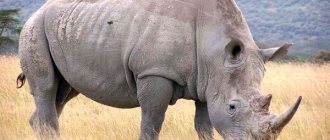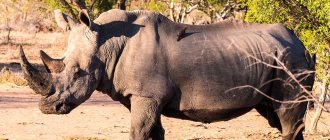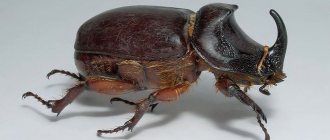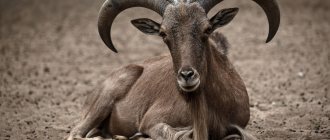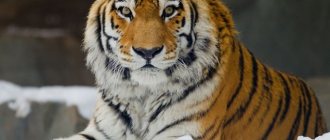Appearance
At the moment, the elephant is considered the largest living creature, and the second place among the giants of the world fauna, without a doubt, is occupied by the rhinoceros. This is a land animal, which in size can reach five meters in length, a height from one and a half to three meters and a weight of up to 4 tons. People mistakenly believe that the skin color is known in the name of the species - white or black rhinoceros, but here the situation is not entirely correct. Both members of the family have approximately the same color – different shades of gray. And they received the difference in name due to the peculiarity of their lifestyle, since this huge mammal loves to wallow in mud, which gives the color, from which two different names appeared.
The head of this animal has a very steep slope in the forehead area, the shape is quite narrow and the head occupies about a quarter of the entire length of the body. Between the nose, on which a huge horn flaunts, and the forehead, with which the giant is capable of breaking through walls, there is a small depression resembling a saddle or something like that. The animal's eyes look awkward, since they are very small compared to its masses, the pupils are black, and the shape is oval. Barely visible eyelashes are located above the eyelids.
Black and Indian rhinoceroses have a peculiarity - their upper lip is very mobile, as a result of which it hangs down and almost completely covers the lower lip. This has not been observed with other brothers. The jaws are massive, have a strong bite and are capable of crushing any animal that gets into them. Some teeth often fall out or are missing altogether, for example, the African species does not have several incisors on both jaws. These mammals do not have fangs, but seven molars, which wear out during life, allow them to grind food no worse than other herbivores are capable of doing. The lower jaw also contains sharper and longer incisors, which the animal uses to cut grass.
Giants have almost no fur on their entire skin. It can be found only at the tips of the ears or at the end of a thin tail, the length of which varies from 60 to 80 centimeters. It is precisely because of the lack of any hair that rhinoceroses have to constantly cover themselves with mud so that small parasites or midges do not bother them. They have so much skin that it gathers into numerous folds and thanks to them the animal looks like some kind of knight in plate armor.
The rhinoceros's hooves have three toes, and their print is very similar to clover leaves, since due to the mass the animal rests on all its limbs, never rising on its toes.
The largest amount of wool is observed in the Sumatran species.
Characteristics and description of the animal
Rhinoceroses lead a solitary lifestyle. Only females with cubs can form temporary small groups. Each animal occupies a certain territory, which it leaves only in case of food shortage. Rhinoceroses mark the boundaries of areas with excrement. Animals entering other people's lands may be attacked by the owner of the territory. But at a watering hole, rhinoceroses never show their aggressive nature either towards representatives of their own species, or towards other herbivores and even predators.
Peak activity of giant mammals occurs in the morning and evening. During the hottest hours, African rhinoceroses prefer to rest in the shade, while Asian species hide from the heat in the water. To protect their skin from sunburn and insect bites, animals periodically roll out in mud, which, when dried, forms a protective crust.
Rhinoceroses do not have acute vision and navigate mainly through hearing and smell. The running speed of massive and clumsy animals at first glance reaches 40-45 km/h.
What does it look like
Indian
appearance of rhinoceroses has the following characteristic features:
| Body | Massive, squat, on the neck there is a large fold of fat in the form of a hump. |
| Legs | Thick and short, ending in a wide foot formed by three toes with small hooves. |
| Head | Strongly elongated, on a short massive neck. Ears are long, mobile, eyes are small |
| Muzzle | Elongated, in the upper part there are growths resembling a horn. The shape, length and number of horns depend on the variety. |
| Tail | Short and thin, ending in a small tassel. |
How much does it weigh
Sumatran
The largest living rhinoceros is white. The weight of some adult males reaches 4 tons. The height of the animal is 1.8-2 m, and the body length is 4 m.
The sizes of other members of the family are noticeably smaller. Thus, the average weight of an Indian rhinoceros is 2 tons with a body length of 3 m. The smallest existing species is the Sumatran. His weight ranges from 800 to 1500 kg, height - 145 cm, body length - 235 cm.
Structure
As the name suggests, the key feature of the rhinoceros's body structure is the horn located on the frontal or nasal bone. Usually this is a single growth, but it can also be a pair of growths. Unlike other animals that also have horns or other outgrowths, such as antelopes or bulls, the horn of a giant mammal is not made of bone tissue, but of the protein keratin. It also makes up the quills of hedgehogs, porcupines, human nails and hair, and even the shells of turtles and armadillos. The composition of these horns is very similar to their hooves. Development occurs from the epidermis, so the outgrowth is not a separate part of the skeleton. If wounded or completely destroyed, the horn is restored, but if it is beaten off along with the root, the adult will forever lose its main weapon. No matter how much time a person spent studying the role of horns in the life of an animal, their main function could not be learned. But you can notice that females, after removing their horns, do not want to enter into relationships with the opposite sex and completely forget about their offspring. At the moment, the most likely theory is the convenience of the rhinoceros, which, with the help of its outgrowth, moves apart trees and grass to find better and more nutritious food. This version is also confirmed by age-related changes in the structure of the horns themselves, which become denser over time, but become smoother.
Bloody deer antlers
Reindeer, once one of the most abundant inhabitants of the Arctic, are disappearing. There are practically none of them left on Novaya Zemlya.
According to the World Wildlife Fund (WWF), over the past 10 years, the Taimyr population of wild reindeer has decreased by almost half. Today there are less than half a million individuals.
Reindeer antlers (antlers during the period of annual growth) are in great demand on the market. Poachers are driven by unbridled greed. Antlers cost a lot of money. It is believed that antler infusion is the most effective remedy against all forms of sexual impotence.
Deer hunting often takes on a barbaric character. Antler hunters fly up in motor boats, lift the deer by the head, use a cordless grinder saw to cut off the antlers in 15–20 seconds and throw the victim into the water. This is a severe shock for the animal. The antlers, covered with thin velvety skin, are saturated with blood, where the nerves pass. Young, unhardened antlers are the most sensitive part of a deer's body. This brutal procedure can be compared to the amputation of a human limb.
In addition to the antlers, the tongues of the killed deer are cut out and the kamus (skin from the deer shin) is cut off. It is used for sewing national shoes - high boots. If emergency measures are not taken to save the reindeer, it may soon be gone.
Rhino species
Nowadays there are quite a lot of subfamilies and other relatives of rhinoceroses in the world, but of the species there are only five main ones, which belong to four genera:
The Sumatran rhinoceros is the rarest representative, the distinctive feature of which is considered to be a huge amount of hair, unusual for other brothers. It is literally covered all over with hair, so it has a family-specific appearance. At the moment, this is the last survivor of the most ancient species. Habitat: Eastern India, Burma and Bangladesh. Anecdotal evidence suggests that animals have been found in the Malay Peninsula, as well as in Cambodia and Vietnam.
Sumatran rhinoceros
Indian rhinoceros , as well as Javan - in the classification they are not related and represent separate categories, but are related to the general genus of Indian rhinoceroses. They are also on the verge of extinction, are strictly protected and have one large horn among their distinctive features. Previously they were a single species, but several tens of millions of years ago they separated, although they did not acquire any significant differences from each other. Habitat: As the name suggests, the main population of the mammal is located in India, as well as in Nepal. According to some data, one can also find out that some part of the population has survived in Bangladesh. The largest number of individuals is found in Kaziranga Park, which is located in the state of Assam. About a third of the entire global population of the species lives there.
Indian rhinoceros
The white rhinoceros is the owner of the largest horn, the length of which can reach almost 170 centimeters in length. It is practically no different from its brother, the black rhinoceros, in terms of external characteristics and most other parameters; together with it it belongs to a single African species. Distinctive features include the diet, which largely consists of grass growing on the ground, as well as mud, in which the animal prefers to swim. Habitat: The majority of individuals are located in South Africa.
White rhinoceros
The black rhinoceros is a similar species to the white rhinoceros, which differs only in the mobility of the upper lip and the way it feeds. It eats vegetation that is located on the branches of trees or bushes, and categorically avoids grass from the ground and eats only in extreme cases. Habitat: same as white.
Black rhinoceros
Rhinos have friends
First, there are buffalo birds. The size of these birds, which are very widespread in Africa, is comparable to the size of a starling. They destroy blood-sucking insects that have burrowed into the skin of rhinoceroses. Buffalo birds not only relentlessly follow the rhinoceroses, but also warn their feeders of impending danger. Second helpers are water turtles that live in local mud baths. By feeding on the above-mentioned insects, they make life much easier for rhinoceroses. Moreover, these turtles are not afraid of such a huge size of a rhinoceros - as soon as he lowers himself into the bath, they immediately get down to business!
Lifestyle
Unlike most other artiodactyls of enormous size, this family prefers to settle alone, not gathering in herds even during migration. Of all the species, only white rhinoceroses can, under certain conditions, unite in small groups in order to quickly find food and also protect themselves from predators. In addition, the cubs also live together for some time and are raised by several females in the area. But even a love of loneliness and detachment does not negate the fact that representatives of rhinoceroses are very friendly towards some other families. For example, voloklui - birds that accompany most of the largest mammals, such as buffalos, giraffes and elephants, are also often found near rhinoceroses. They enter into some mutually beneficial relationships, since the lack of hair on the body does not allow the giant to fully protect himself from insects and other parasites, and birds, as everyone knows, eat them. Therefore, the wolves feed on the lack of rhinoceroses, and they live quietly and do not get sick with various diseases, the carriers of which are often insects. Smooth skin makes it easier for ticks to attach to the body, and mud baths are not always able to cleanse the animal of pests. But they are inhabited by mud turtles, which help the giants and gnaw off their ill-wishers from their skin.
The protection of the territory in which mammals live is very strict for this family. The individual selects an entire area, which has both a pasture and a pond, after which it does not even allow its own brothers into the territory. Over time, they trample down boundaries that others are absolutely forbidden to cross, and also allocate their own places in the mud baths, over which they can even start fights. It is noteworthy that the African genus even creates a territory for litter. During its life, huge mountains of manure accumulate in it, which emits a smell and makes it clear that this place is already occupied, you should not approach it. A way to mark its boundaries can be not only feces, but also urine, which the animal sprays on bushes and grass.
Black rhinos are active at night. During this period, they stock up on food so that they can lie somewhere in the shade for the rest of the day and sleep. Sleep, by the way, takes place on the stomach or side, since if the giant lies on his back, he is unlikely to be able to get up on his own. These lumps actually have a very sound sleep, which cannot be disturbed even by the roar of an approaching predator - they absolutely do not care what happens and where, because they are sleeping. At this time, some fearless tourists can run up to the lying body and grab it by the tail, but it will not even react, because sleep and food are above all else for rhinoceroses. Other species do not have such strong indifference to danger, so their sleep is more sensitive, and their activity may also occur during the daytime.
Rhinoceroses are inherently very cautious, despite their size, which could give them a high ego. They stay away from people because they see them as a potential threat, and they also try to avoid danger. But, if a predator or other ill-wisher appears on the horizon, instead of running away, they attack first, demonstrating their fearlessness and showing that they have no equal in strength. The speed of a running rhinoceros, even considering its size, is quite high and can reach fifty kilometers per hour. Representatives of the black species are more aggressive, so they can even attack themselves, regardless of whether something threatens them or not. In fact, no other inhabitant of the fauna is able to stop such a giant, and their running strike is almost always fatal for the enemy. The white species is more peaceful, so it is often bred for sale to exotic lovers or to zoos, because a baby raised by a human will not even mind people communicating with it in the future. Some mature females can allow themselves to be milked, but this happens extremely rarely, so it is better not to risk it.
The range of sounds that a rhinoceros can make is actually very wide. They grunt, squeal, scream, snort, sniffle and even moo. If the mammal is disturbed or frightened, it begins to snore and grumble loudly, and then may even attack if it feels threatened. Grunting is produced by females who call their babies to them, and they begin to squeal squeaky if they do not find their mother next to them. When wounded or in battle, this mammal makes a loud roar, and mating is accompanied by a slightly comical whistling from the female.
During forced migration, quite a large number of individuals die while trying to cross a body of water. This is the biggest obstacle for giants, because they can either bypass a wall, tree or stone, or simply demolish it, but their swimming skill is almost not developed - this is facilitated by the mass, which does not allow the animals to float on the water, as a result of which they immediately go to the bottom and are drowning. But during evolution, Indian rhinoceroses acquired the ability to swim well, so only they and the Sumatran species are able to survive when crossing some deep river.
Horn like weapon
The rhinoceros is a very large animal. In appearance he seems clumsy and slow. This is not true at all. A rhinoceros can reach speeds of up to forty-five kilometers per hour, but this is not enough to escape from a predator. Many believe that the rhinoceros's horn is its weapon against attacks from hungry carnivorous animals. This is also not entirely true. The rhinoceros has no enemies in the world of predators. His appearance is so formidable that few lionesses and hyenas would dare to attack him, trying to catch him as food. If, at the most hungry time, there is a brave man trying to attack the big guy, then the rhinoceros has only to shake its horn once towards the attacker on his life, and the predator runs away. There is also an opinion that rhinoceroses use their horns to fight other males. During the mating season, when everyone wants to attract the attention of the healthiest and most beautiful female, rhinoceroses begin to fight for advantage. But to prove their strength, they do not use horns at all, but teeth. Males attack each other, biting the enemy and knocking them down with their entire body. And the fact that a rhinoceros can hook a person on its horns is completely out of the realm of science fiction. This is the most peaceful and calm animal. He avoids meeting a person, and if they meet, he will hasten to run away and hide, and very rarely attacks. Unfortunately, the same cannot be said about people. They are the main enemy of the rhinoceros, exterminating the species.
How long do rhinoceroses live?
The lifespan of a rhinoceros actually varies greatly from species to species, but one thing is certain - they are capable of living for quite a long time. In captivity, for example, in zoos or nature reserves, the average lifespan is about fifty years, but in the wild, black and white rhinoceroses die before they reach 45. The Sumatran is considered the shortest-lived, since its main feature is the presence of an abundant amount of wool, which contributes to enormous attention from poachers who want to make a profit without sparing the animal. The Indian and Javanese species are considered long-lived, which is facilitated by climate and nutrition, as well as the absence of natural enemies and careful protection by humans. Their average life expectancy is about 65 years.
Horn for tags in the territory
In nature, you can see a picture of a rhinoceros rubbing its horns against a tree, after which huge scars remain on the bark. This is how the animal marks its territory, leaving traces and smell. Rhinos are loners. They do not like the company of their relatives. If on the path of the animal there is a tree on which there is the smell of another rhinoceros, then this will be a reason not to stay in this area for a long time. The only time a rhinoceros can be seen in a pair is a mother and calf. The female raises the baby until two years old, and then they separate.
Where do they live?
Once upon a time, the family included a huge number of species, but climate change, as well as human activity, destroyed almost all of them, leaving only five main species. They all prefer to live in warm or even hot conditions, so they simply cannot be found on cold continents. The main habitat is considered to be Southeast Asia and South Africa. Some parts of the population of any of the species can be found in the steppe zones and savannas of the Congo, Mozambique or several other arid countries. In extreme cases, rhinoceroses begin to live in the tropics, even despite the presence of rain and a humid climate there.
Video
And finally, an interesting video about crazy rhino attacks caught on camera.
Author: Pavel Chaika, editor-in-chief of Poznavaika magazine
When writing the article, I tried to make it as interesting, useful and high-quality as possible. I would be grateful for any feedback and constructive criticism in the form of comments on the article. You can also write your wish/question/suggestion to my email [email protected] or Facebook, with respect, the author.
Author page
This article is available in English - Rhino (Rhinoceros).
What do they eat?
Since rhinoceroses are classified as herbivores, they are exceptional vegetarians and do not eat meat or other flesh even in extreme cases. It is logical that, due to certain mutations and deviations, some individual individuals are capable of attacking another animal with the aim of eating it, but this is only an exception to the rule.
To maintain such a huge weight and size, mammals have to consume up to hundreds of kilograms of plant food per day, which seems completely impossible figures. The diet depends on the species, for example, white rhinoceroses are selective in their food and do not eat anything except grass growing on the ground. But black rhinoceroses eat completely the opposite, although these two species are almost indistinguishable and live next door. They, along with Indian rhinoceroses, eat bushes, as well as foliage and branches of trees growing near pastures. They don’t eat grass because they consider it tasteless. They are able to pluck food from a height thanks to the special structure of their upper lip, which more closely resembles a small proboscis that encircles branches and tears off all vegetation from them. In addition, the Indian rhinoceros especially loves to eat sugar cane shoots, which are quite abundant in the habitats of this mammal. Representatives of the black species, in turn, love to eat the so-called elephant grass, as well as water shoots and tree fruits. Sumatran giants are especially different from the rest because their habitat allows them to feed on abundant fruits and berries, such as figs and mangosteens. The Javan lump is the most picky and eats what it finds.
Walk to the watering hole
When a rhinoceros comes to a watering hole, he is calm about the fact that other animals drink water next to him. Every day he takes walks to the stream, covering a distance of sometimes ten kilometers. Purposefully and slowly, the rhinoceroses walk along a familiar path, trodden by more than just the paws of animals.
Rhinos can drink fifty liters or more of water a day. Having drunk to their heart's content, they bask in the mud or are in the shade. Rhinos often spend their leisure time without getting out of the water. In the evening, when the heat subsides, they begin to run briskly and make joyful sounds.
Read also: How to crochet bells?
Reproduction
Sexual maturity in giant mammals occurs only in the seventh or eighth years of life, which is relatively late compared to many other giants. But the search for a female and, accordingly, reproduction will not begin until the male marks his own territory, and then protects her several times from the encroachments of other males in order to prove his strength and readiness. This usually takes up to five years of life, and by the age of eleven the animal can finally begin to reproduce. The mating season occurs at the beginning of spring, but most species do not have a specific season, since their rut occurs every 1-2 months. Males arrange very brutal fights among themselves, but the peculiarities do not end there. Having fought and defended his strength, the male finally becomes interesting to the females, but before mating, both sexes arrange a small race between themselves, during which they may even have a small fight.
The duration of pregnancy in females is on average one and a half years, so only one baby is born every 2-3 years. The weight of a newborn baby can reach 60 kilograms, and white rhino cubs at birth have a large amount of hair, which soon falls out. The baby comes to his senses for a few minutes, and then gets to his feet and follows his mother the very next day. After three or four months, the still very young individual is ready to get food for itself, but lactation still takes some time.
When the female has a new baby, the adult is driven away and forgotten about, but he soon returns, which is why the mother can start a fight with him in order to explain in a more understandable language why he should leave.
Feeding characteristics of the Indian rhinoceros
The Indian rhinoceros is a herbivore whose diet includes aquatic plants, young shoots of reeds and elephant grass. He snatches food with his keratinized upper lip. Grazing occurs in the morning or evening, when it becomes cool; rhinoceroses wait out the heat in small lakes and puddles that are filled with liquid mud. Rhinoceroses also look for their food in bodies of water, which is why they are common only in wet, swampy areas.
Population
The cost of the horn of this mammal on the black market is one of the most expensive in principle. By the beginning of the 2000s, not even ten percent of the former population remained, since poachers destroyed almost everyone. Humanity finally noticed the problem and decided to create nature reserves, laws and other measures to protect and save the species, but the population decline continues to this day. Alas, the current world is not adapted to full-fledged measures that can somehow stop the merciless murders. Recently, some subspecies have simply disappeared, although it would seem that bills and other protection measures have already been created.
In 2011, the western black rhinoceros species was declared extinct, and of the northern white rhinoceroses, only one individual remained alive worldwide.
Despite the limited number of individuals, there are full-fledged traditions and workshops in China or Vietnam that offer rhino horn carving services and also use them for medicinal purposes.
Rhino horn for all diseases
Things are no better with the African rhinoceros population. Over 30 years (from the mid-60s to the mid-90s), the number of these animals decreased by 97%. The belief that its horn could serve as a cure for many diseases, as well as a cure for infertility, turned out to be disastrous for the rhinoceros.
But the biggest blow to the survival of these animals came from rumors about the effectiveness of a cancer cure that could supposedly be prepared from rhinoceros horn. People are ready to give any money for a drug that can cure this disease. The price of a kilogram of horns is rapidly approaching half a million dollars.
Belief in the healing properties of rhinoceros horn and the growing demand for it are fueling poaching, which is becoming increasingly alarming. If this continues, there will be no more rhinoceroses left in the wild.
Natural enemies
Adults, in principle, have no enemies except humans. No laws or security measures can stop poachers, since these people are able to bypass any means of protection for the sake of money.
Elephants and giraffes, which are also giants of the fauna and make up the three largest creatures on planet Earth, treat rhinoceroses with respect. But sometimes a battle for food can take place between them if none of the individuals wants to give in.
But the cubs are unlucky, since their strength is not as great as that of adults or at least young animals. If the baby gets away from the female, then he will most likely be eaten by a crocodile, lion or tiger. But if the female notices a predator, then he is more likely to die from just one blow, because her horn is very powerful and is capable of demolishing any obstacle in its path.
Parasites and other pests are the most dangerous creatures for rhinos, since they have no way to protect themselves, as a result of which they just need to endure and try to take mud baths more often.
Enemies of the rhinoceros in the wild
Rhinoceroses are perhaps the only herbivores on the planet that have no natural enemies. After all, these are such large and powerful animals, and even possessing such deadly weapons as a sharp horn, that not a single predator would dare to challenge them.
Even the king of beasts himself tries to quickly get out of the way of the rhinoceros
Rhinoceroses are avoided by formidable lions, cunning hyenas, and fearless tigers; in general, not a single four-legged hunter of the African savannas and Asian jungles considers these giants as potential prey. Moreover, predatory animals do not even dare to attack baby rhinos, let alone engage in combat with an adult.
Predators do not pose a threat to rhinoceroses, but they do have conflicts with other herbivorous neighbors. And we are talking about yet another giants of the animal world: elephants and hippos. And more often than not, it is rhinoceroses who are the instigators of fights, and it’s all due to their impulsive and irritable disposition.
Sometimes a rhinoceros decides to compete with such a giant as an elephant
In most cases, having met on the same path, these thick-skinned giants peacefully go about their business. But sometimes a rhinoceros, for unknown reasons, attacks an elephant, and the elephant has to “reason” with its enraged neighbor. True, the battle between these animals is rather symbolic in nature. After all, a rhinoceros cannot cause much harm to the enemy. And the elephant, in turn, does not seek to kill the rhinoceros, but simply pushes the cocky duelist away with its trunk, and he, realizing that the superiority of forces is on the enemy’s side, quickly calms down and gives way to him.
But the battles between rhinoceroses and hippos are more fierce, because both animals are famous for their stubbornness and hot-tempered character. Their meetings take place in reservoirs, where hippopotamus rookeries are located, and often they pay little attention to rhinoceroses who come to the watering hole. But, again, for inexplicable reasons, a rhinoceros can suddenly attack a hippopotamus, simply tearing it apart with its horn. Or a hippopotamus, being in a bad mood, without warning grabs a rhinoceros by the head and literally drowns its thick-skinned neighbor in muddy water.
But fights between herbivorous giants are so rare that they can be considered an exception to the rule, and not a pattern. So the only truly deadly enemy of the rhinoceros is not another animal, but man. After all, people have been mercilessly exterminating these creatures for centuries, trying to get such a valuable trophy as a rhinoceros horn.
Hunting for them is prohibited everywhere, and the killing of a rhinoceros is punishable to the fullest extent of the law, but this does not stop poachers who are greedy for easy money, because of whose greed these amazing creatures are on the verge of extinction.
Interesting Facts
- The skeleton of one of the most ancient species, the woolly rhinoceros, can be found in the Tomsk State Museum. People collected it from the bones of different individuals, which were somehow similar in structure. The length of the horn of this animal is about 120 centimeters, and the height of the skeleton is 160-170. The scientists also noted that the woolly rhinoceros's horns likely increased in size throughout its life.
- Several million years ago, in the Eurasian forests in the Quaternary period of the Cenozoic era, there existed one of the largest species of rhinoceroses - Diceros merki, which translated from Latin means Merc's rhinoceros. But the largest in history is considered to be Indricotherium, which lived about thirty million years ago. He was several times larger than modern elephants, and his height exceeded 8 meters, which means that giraffes are also smaller than him. The body mass of such a monster reached twenty tons, so it is still unknown how strong the blow of this creature would be.
